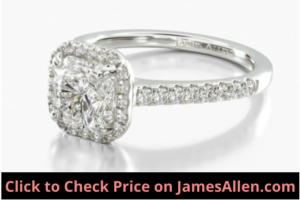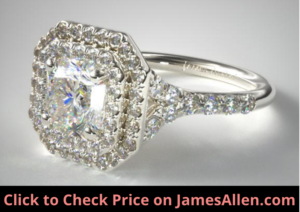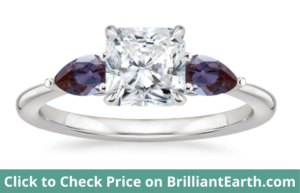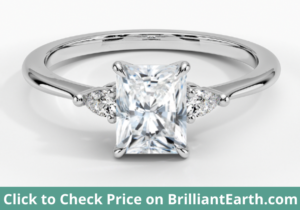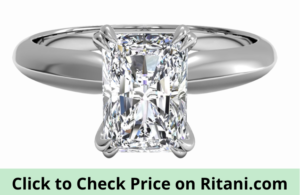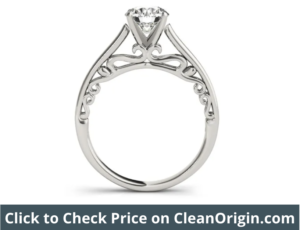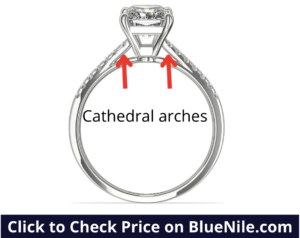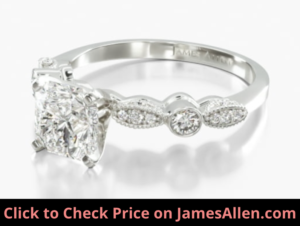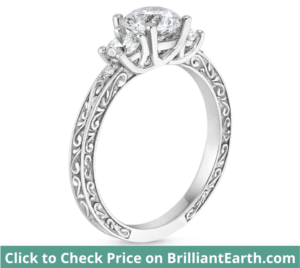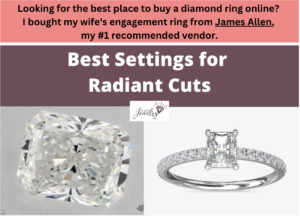
Radiant cut diamonds are regarded for their square and rectangular shapes and cropped corners.
Often cut with a length-to-width ratio between 1.00-1.50, its outline is similar to a cushion or princess cut. But its straight edges surround 70 brilliant-cut facets that offer exceptional fire and brilliance.
If you’ve decided on a radiant cut for your diamond ring, it’s important to choose the right setting.
Here are the 5 best settings for radiant cuts and why each design makes the list.
1. Halo Settings
Halo settings have a ring of small diamonds around the main one.
The reason it’s a fit for radiant cuts is because the shape of the halo complements the center diamond. Take this halo setting in 14K white gold as an example.
Notice how the four corners that comprise the halo have cropped corners that match the shape of the radiant cut. When a halo is placed against a round cut, it’s a circle instead.
So you don’t have to worry about the squarish shape of a radiant cut contrasting with the outline of the halo.
It also has the added benefit of causing the radiant cut in the middle to appear larger. When viewed from a distance, the halo and center diamond appear as one, as long as they’re of similar clarity and color.
The strong brilliance of the radiant cut and halo result in beams of white light, which further blends the diamonds together.
You also aren’t limited to a single halo. Instead, there are double halo settings available for radiant cuts with two layers surrounding the diamond.
The second halo is often uniform with the first. It’s an effective way to increase the apparent size of a ring and its total carat weight without the corresponding price jump of a larger center diamond.
Not all halo settings are simplistic designs. This radiant cut is surrounded by a floral halo, where the setting rises and falls as it encircles the diamond.
It demonstrates how within this style of setting, there are an endless number of designs for your radiant cut.
2. Side Stones
Side stone settings are a popular choice because they enhance the aesthetic of the entire piece without distracting from the radiant cut at the center.
It refers to a setting with one or more gems flanking the main one. They’re often diamonds but can also include sapphire, rubies, or alexandrite, like this setting.
One of the most common types of side stone settings has tapered baguettes on each side. They complement any diamond cut, especially radiants.
Instead of several tiny diamonds running down both sides of the ring, like you’ll find on a pave or micro pave setting, tapered baguettes are a simple but elegant design.
Check out this version in 14K yellow gold.
The subtle glow from the baguette diamonds causes the radiant cut to exhibit even more brilliance.
Side stone settings aren’t only available with baguettes. They feature almost any diamond cut.
The style below has a pear cut on each side of the radiant diamond.
These shapes aren’t often paired together, but if you’re searching for an alternative to the classic round shape that still pairs with radiant cuts, this could be the right choice for you.
For maximum brilliance, side stones can adorn a ring with pave diamonds lining the shank. This creates three distinct sections of the ring: the radiant diamond on top, the side stones on each end, and smaller accents running down the band.
Although it might detract from a larger main gem, it’s an exceptional decision if you’ve opted for a smaller radiant cut.
3. Solitaire
Solitaire settings are the classic style that fit every cut, including radiants.
There are many options to explore, even though it only includes on diamond.
We’ll start with this knife edge ring.
There are double claws on each corner that secure the radiant cut on the setting. The distinguishing feature of the knife edge ring is it slopes up from the edges to meet a high line in the middle.
The band is split in two.
In most cases, knife edge bands are thin, which can highlight the size of the diamond in comparison. If your radiant cut is under one carat, this could be a suitable choice.
If you aren’t interested in additional diamonds on the ring but want an alternative to a simple setting, consider a solitaire setting where the shank has a distinct design.
The solitaire below is compatible with radiant cuts, where it’s supported by a ring with a filigree styled profile.
From the top-down view, it will appear as a normal solitaire setting, but from the side, it offers an aesthetic not found in most pieces.
And as with other types of settings for radiant cuts, solitaires are often available in yellow, white, and rose gold and platinum.
4. Cathedral Settings
In a cathedral setting, radiant cuts are supported by two arches that extend from the top of the shank to hold the diamond.
Triangular gaps appear below.
Similar to the example above, its unique qualities are most apparent when viewed from the profile.
In most cases, it’s a high setting. The diamond is prominently displayed above the ring, which allows it to capture and reflect more light.
This is beneficial for radiant diamonds because they’re cut to maximize brilliance.
But high settings like cathedrals are also prone to catching on everyday items and experiencing impact, so it’s important to remove them during physical activity.
Most cathedral settings, like non-cathedrals, have four prongs, but the style doesn’t require them. That’s because the cathedral is referring to the arches below the diamond instead of how it’s held.
So it could have a ring of metal wrapped around the diamond, called a bezel setting.
In some cases, cathedral settings are lined with pave diamonds, like this one in 14K white gold.
It demonstrates how most types of settings for radiant cuts aren’t exclusive. You can combine different styles to customize its appearance.
5. Antique Settings
Antique settings mimic styles that were popular in previous eras. Some of the most common are the Art Deco, Edwardian, and Victorian periods.
Traditionally, antique settings are passed down from prior generations, but many jewelry retailers manufacture new iterations of these designs for every type of cut, including radiants.
There isn’t a single feature that earns a setting the label of antique, but you’ll frequently find them with filigree or milgrain.
This antique bezel setting with pave provides an example.
Notice how on both sides of the diamond there are two marquise cuts surrounding a round cut. Outlining those accents are small beads of milgrain.
In the white gold version, the accents and milgrain blend in with the ring because of their similar color. But if you switch it to yellow gold, which you can view here, the contrast helps them stand out.
Some antique settings are pure elegance, where there’s attention to detail on every part of the piece. Take the below three-stone trellis setting.
Starting at the top, there’s a radiant cut diamond held by four rounded prongs.
On each side, it’s flanked by two round-cut gems. One is noticeably larger than the other, but each is smaller than the radiant cut.
The interwoven prongs of the trellis setting meet the top of the ring, where it transitions into a scroll pattern on the top and sides.
Not only does the setting exhibit strong brilliance on top, the antique design touches each aspect of the radiant cut engagement ring.
6. Pavé
Pavé refers to a row of diamonds “paved” along the ring. They’re held in place by tiny prongs or beads that minimize how much metal is visible.
That way, it adds more brilliance to the piece when it’s twirled.
Pavé settings are fit for any diamond cut, but they’re especially complementing of radiant cuts because it compensates for its lack of brilliance compared to a round-cut diamond at the center.
Although radiant cuts still demonstrate light performance, it doesn’t match a round cut.
Here’s an example of a radiant cut engagement ring with a pavé setting in 14K rose gold.
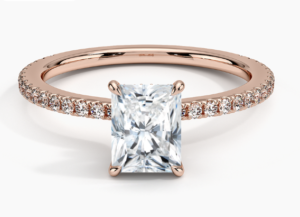
It’s a helpful view because you can identify how the pavé is set on top of the ring. There are 44 small diamonds that weigh a total of 0.30 carats.
At less than 0.01 carats per diamond, they don’t distract from the main one but still offer an alternative to radiant cuts with a solitaire setting.
If you choose pavé, you aren’t limited to that feature. Instead, you might decide to include a halo, like the example below.
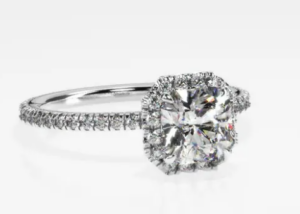
Explore the various styles of pavé settings to learn which is right for your radiant cut.
7. Channel
My last recommendation for a radiant cut setting is chanel.
Channel settings feature a shallow crevice within the ring that holds several diamonds. A small lip reaches over the crown to secure them in place.
At first glance, you might not notice the difference between pavé and channel because they both involve additional diamonds on the band.
The distinction is channel-set diamonds are in the ring instead of on top.
Within the category, there are different styles.
For example, check out the differences between these two.
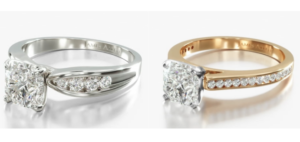
The engagement ring on the right only has three channel-set diamonds, but they have a higher total carat weight (0.30) compared to the one on the left (0.23).
The reason radiant cuts are an exceptional fit for channel settings is because it enhances the overall brilliance and increases the total carat weight of the piece, without the price increase associated with a larger center diamond.

Jacob Clarke
Jacob Clarke is the founder of TeachJewelry.com.
He earned an Applied Jewelry Professional Diploma from the Gemological Institute of America (GIA) and now brings you essential information about diamonds, settings, and more.
Jacob has consulted with leading jewelry brands, and his work has been cited in Clean Origin, Diamond Nexus and industry publications.
He's also a member of the International Gem Society.
He enjoys discussing jewelry with readers, so contact him with any questions at jacob.clarke@teachjewelry.com.

